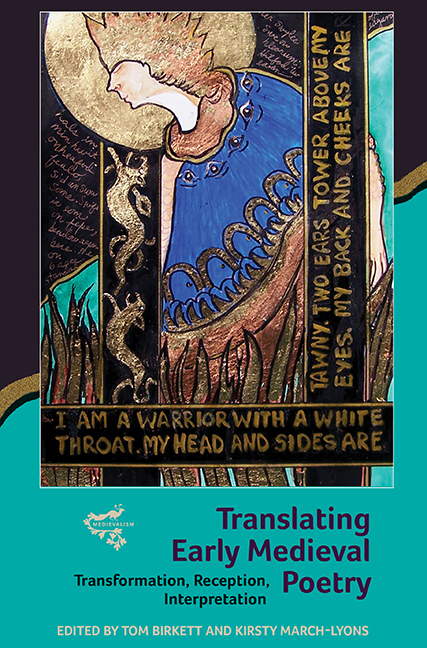Book contents
- Frontmatter
- Contents
- Acknowledgements
- Contributors
- Introduction: From Eald to New
- 1 From Eald Old to New Old: Translating Old English Poetry in(to) the Twenty-first Century
- 2 Edwin Morgan's Translations of Anglo-Saxon Poetry: Turning Eald into New in English and Scots
- 3 Gains and Losses in Translating Old English Poetry into Modern English and Russian
- 4 Borges, Old English Poetry and Translation Studies
- 5 ‘Let Beowulf now be a book from Ireland’: What Would Henryson or Tolkien Say?
- 6 The Forms and Functions of Medieval Irish Poetry and the Limitations of Modern Aesthetics
- 7 Aislinge Meic Conglinne: Challenges for Translator and Audience
- 8 Translating Find and the Phantoms into Modern Irish
- 9 Reawakening Angantýr: English Translations of an Old Norse Poem from the Eighteenth Century to the Twenty-first
- 10 Translating and Retranslating the Poetic Edda
- 11 From Heroic Lay to Victorian Novel: Old Norse Poetry about Brynhildr and Thomas Hardy's The Return of the Native
- 12 Michael Hirst's Vikings and Old Norse Poetry
- Afterword
- A Translation of Riddle 15 from the Exeter Book
- Bibliography
- Index
- Miscellaneous Endmatter
Afterword
Published online by Cambridge University Press: 01 September 2018
- Frontmatter
- Contents
- Acknowledgements
- Contributors
- Introduction: From Eald to New
- 1 From Eald Old to New Old: Translating Old English Poetry in(to) the Twenty-first Century
- 2 Edwin Morgan's Translations of Anglo-Saxon Poetry: Turning Eald into New in English and Scots
- 3 Gains and Losses in Translating Old English Poetry into Modern English and Russian
- 4 Borges, Old English Poetry and Translation Studies
- 5 ‘Let Beowulf now be a book from Ireland’: What Would Henryson or Tolkien Say?
- 6 The Forms and Functions of Medieval Irish Poetry and the Limitations of Modern Aesthetics
- 7 Aislinge Meic Conglinne: Challenges for Translator and Audience
- 8 Translating Find and the Phantoms into Modern Irish
- 9 Reawakening Angantýr: English Translations of an Old Norse Poem from the Eighteenth Century to the Twenty-first
- 10 Translating and Retranslating the Poetic Edda
- 11 From Heroic Lay to Victorian Novel: Old Norse Poetry about Brynhildr and Thomas Hardy's The Return of the Native
- 12 Michael Hirst's Vikings and Old Norse Poetry
- Afterword
- A Translation of Riddle 15 from the Exeter Book
- Bibliography
- Index
- Miscellaneous Endmatter
Summary
WHAT EXACTLY ARE we doing when we set out on a translation? Well, it depends; the first thing to establish is for what purpose and readership we are doing it. Since the early nineteenth century when there was a reinforced emphasis on the theory of translation in works such as Friedrich Schleiermacher's ‘On the Different Methods of Translating’ it has been essential for translators to recognise precisely what kind of version they were aiming at – most immediately whether the objective was correspondence to the original in a new language (what degree of ‘equivalence’ we are aiming at, in Lawrence Venuti's terms), or to produce a new work which was prompted by the original. Not that such considerations were new in the nineteenth century: in the Alfredian Preface to the Anglo-Saxon translation of Gregory's Cura Pastoralis the translator will proceed ‘hwilum word be worde, hwilum andgit of andgiete’ (‘sometimes word for word; sometimes sense for sense’). And of course there are other contexts too: in her very enlightening essay on Borges here, M. J. Toswell refers to Umberto Eco's summary idea of ‘translation as a negotiation involving original text, publisher, economic matters, the target text, various kinds of approaches to the translation and reader responses’.
Not all of these factors are the primary concern for the context here. In her essay on translations of Old English poetry into Modern English and Russian, Inna Matyushina reminds us of a crucial distinction: ‘Translation has traditionally been divided into two types: that on a spatial axis, from one language to another, and that on a chronological axis, within one language of different periods.’ The chronological axis of course is fundamental for translations of Old English to modern – the sole concern of four of the twelve essays here – as it is also for the two essays concerned with translations of early Irish texts into modern languages: Irish in the case of Tadhg Ó Siocháin and English by Lahney Preston Matto. A substantial part of what verse translators do is the recasting of earlier texts in their own language.
The eald languages in the twelve essays here are Old English, Old Norse, and Middle Irish. The ‘new’ languages are Modern English, Modern Irish, Spanish, Scots and Russian, so this is not only a matter of chronological translation.
- Type
- Chapter
- Information
- Translating Early Medieval PoetryTransformation, Reception, Interpretation, pp. 213 - 216Publisher: Boydell & BrewerPrint publication year: 2017

